The number of edtech projects we delivered has significantly grown in the last few years. The reasons are obvious – digitalization of education, COVID-19, etc. During this time, we’ve developed plenty of e-learning applications that focus on entirely different user problems & needs – from a coaching app for corporate learning and Norwegian e-driving school to an application for kids with special needs.
In each project, we used gamification to fix certain business challenges – like poor user engagement or lack of motivation. For example, in a learning app for children with ASD, we gamified all of the exercises. This allowed us to simplify and diversify training of memory, hearing, attention, and rhythm that are especially vital for kids who struggle to study in traditional ways. For our another edtech project, a personalized soft skills coach VUC^it, we’ve added interactive challenges into the course flow which increased the app’s retention rate.
The importance of gamification in elearning
What is gamification in elearning? First’ let’s start from the basics: gamification is not gaming. While games are independent products created for entertainment, gamification is an influence on a certain process. Gamification in elearning is used to enhance and simplify the learning process which is complex by default. Overloaded with intellectual challenges and complicated texts, many edtech apps don’t engage or motivate their users enough and end up with low conversion and retention.
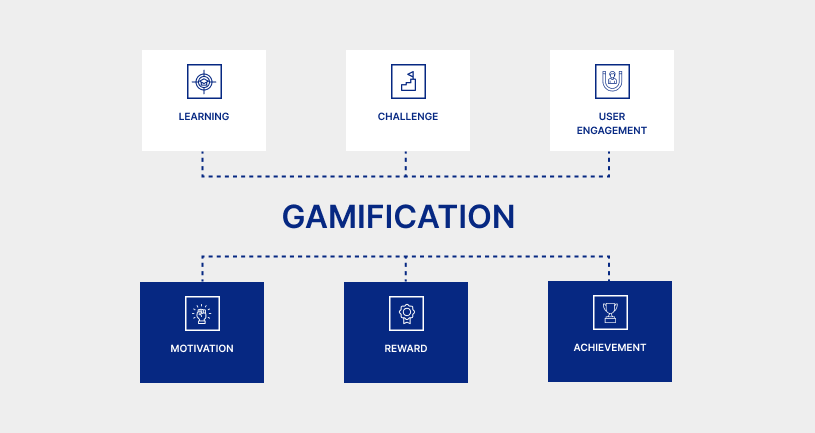
However, with properly implemented gamification, these problems are hardly a concern – gamified e-learning provides educational and entertaining content at a time. For real-life edtech products, this can lead to +60% in engagement and +50% in productivity.
This applies to all types of users – from kids with special needs to 9 to 5 employees. Take the US corporate settings – 80% of workers there prefer gamified learning and find it more engaging and efficient as compared to traditional methods.
How gamification is so powerful
Ever wondered why gamification has such a strong influence on us? That’s because of dopamine, the hormone of pleasure. Basically, the effects of gamification in e-learning rely upon so-called ‘dopamine traps’.
‘Dopamine trap’ is based on 4 simple steps. At first, users receive a trigger – an external or internal motivation to do something (e.g. a notification or reminder to collect more points). Next, uplifted users proceed with the action for which they will get rewarded (task, daily challenge, etc). When it’s completed, users get rewards and their dopamine levels rise. The final step of a loop is all about making users return for more dopamine. Here, edtech apps creators get us on a hook by always leaving some bounties to collect or challenges to unlock, which, in fact, is a trigger that takes users back.
This simple 4-step ‘trap’ works perfectly well on practice – users become dopamine addicts and show up to 89.45% increase in learning performance.
Gamification features for edtech apps
Gamification in elearning can do wonders when properly adjusted according to the specific type & goals of the app. For example, social interactions are a must-have for corporate edtech programs where team-based learning prevails; for kids learning apps, animations and rewards do their part. So, to take the most out of gamification techniques, it is critical to distinguish and correctly implement them.
Challenges & streaks
Challenges and streaks are of the most popular implementations to boost any e-learning app’s retention rate. Stats prove it, too – regular challenges motivate users to come back and complete more tasks leading to improved learning results.
Hence, we often leverage challenges on our edtech projects. For instance, in a career coaching app VUC^it we’ve included an interactive 6-week challenge with self- and group learning to increase user engagement.
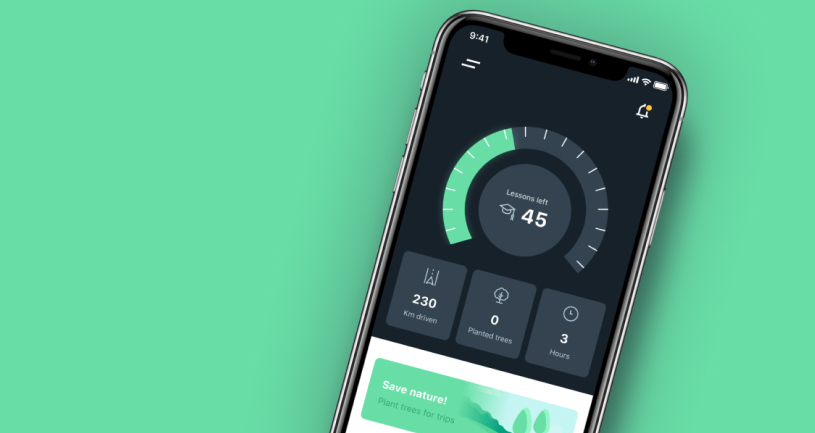
Progress tracking is often a story for language learning apps. Take an obvious example – Duolingo’s interactive bar. It uses different colors for various types of challenges and makes the flow intuitive so that users can easily return to completed challenges for refreshing their knowledge or reviewing previous results.
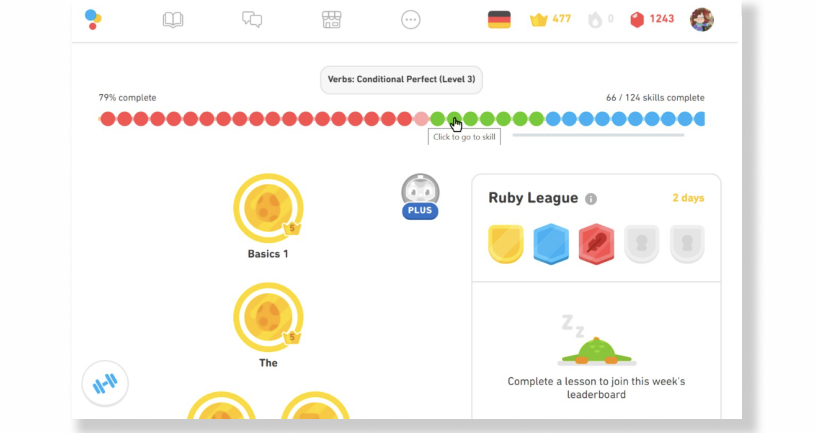
Points & in-app currency
Points and internal currencies are the go-to elements for gamified e-learning apps, as they are essential for retention. Keeping this in mind, edtech apps often award users with internal assets for setting profiles, completing tasks, inviting friends, and more.
Some e-learning platforms use points and internal currencies for monetization. These apps offer top-notch educational content but instead of selling it through subscriptions, they charge users for every lesson or section. When users complete purchased parts, they are granted with reward points that can be used to access paid content for free. Using this pattern, app creators can drastically boost user engagement, retention, and conversion.
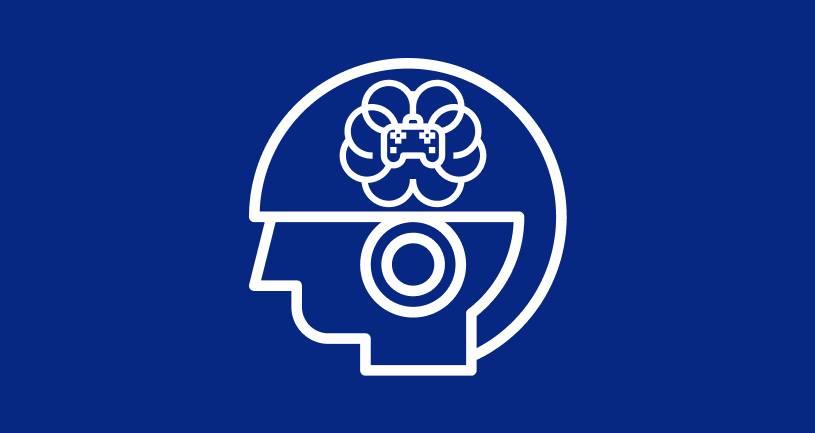
Badges and stickers
Badges and stickers are yet another gamification trick that boosts engagement and gets apps distributed. For users, it’s another proof of their achievements which lets them display the performance. Badges always work out well for the edtech apps, since people love to share their achievements with friends, colleagues, and social media followers.
By the way, giving users the ability to share achievements on social media is a great way of distribution and exposure, too. That’s why, in Duolingo users can share their interim results (e.g., correctly translated sentences) right after they get them – there’s a pop-up that offers to proceed to Instagram, Twitter, and other popular social media in one click.
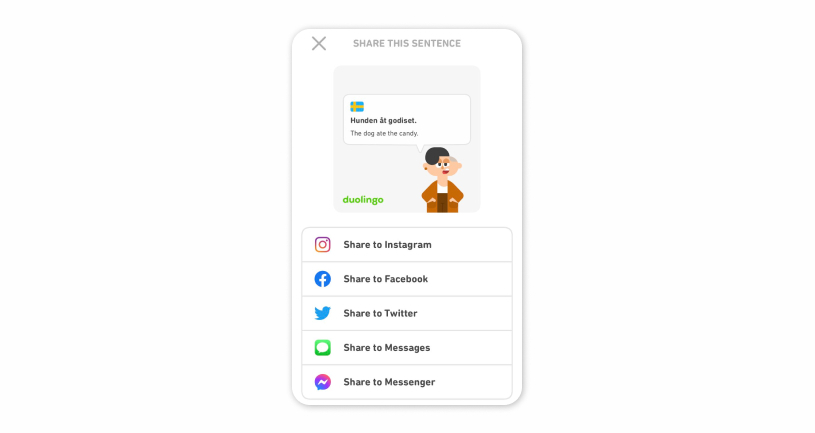
Social interactions
Socialization in e-learning boosts overall engagement and positively affects the learning progress. In a socialized environment where users can monitor each other’s results and rewards, they eventually join the competition and get on the dopamine hook without realizing it.
Moreover, working on versatile tasks in groups, students and tutors need to have live communication. So, to enhance teamwork and time-efficiency for VUC^it users, we’ve designed a group course which included knowledge sharing, group calls, chats, and feedback sessions with coaches along the way.
Rewards & collections
Rewarding users for learning advancements with internal money and collectible items becomes a go-to feature in many edtech apps today. And it’s easy to understand why – these elements of gamification are perfect for setting dopamine traps we’ve already mentioned. The most popular way to utilize this mechanic is to add daily challenges with valuable rewards.
Collections can be anything users like – pictures, characters, sounds, etc. It can even be a whole sound library like the one we’ve added to our app for children with ASD. With it, we wanted to keep kids engaged, motivated and not overwhelmed by learning. Inside the library, children can find and mix rewarded sounds into original DJ sets.
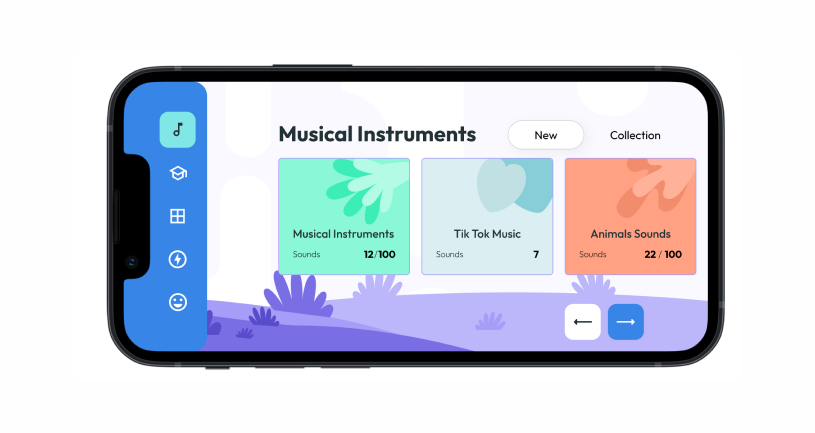
Types of gamers
Adding gamification into edtech apps, it’s also important to distinguish the types of gamers and understand what are the elements of gamification they like. Only this way, both sides can take the most profit out of user-app interaction.
Different user types need different motivation. For example, there are gaming socializers, who mainly seek to communicate and share their content. For this type of users, the integration of teamwork, chats, sharing options, calls, or interactive feed is a must-have.
Challenges, leaderboards, and level progressing are critical for achievers, who primarily focus on “completing” the game. For them, it is also vital to track their progress (don’t forget about progress bars) and share the results (badges and social media can help).
Besides, there are disruptors – users who find most fun in “breaking” game rules. For this type, it is best to set up elements of gamification that allows one to “get creative” and explore along the way, while focusing on learning. For example, some apps offer to check additional related content whenever users give incorrect answers instead of just showing a pop-up with a word “wrong”.
A philanthropist user type is motivated by gifting, taking administrative roles, and sharing knowledge. These users are also ready to pay for extra perks. E-learning apps manufacturers can attract this audience by including customization options, cosmetics, more “lives”, etc. The main point here is to keep balance between what the platform offers to users who donate and to those who do not.
Pitfalls
Gamification also has its shortcomings. Many platforms stick to “the more gamification, the better” principle. Well, typically, such apps end up with UI&UX overshadowed by visual noise that distracts users.
To avoid it, app creators need to define the goals of the app and use gamification only to simplify or enhance the learning process. For example, drivers may like a progress bar looking like a speedometer, but they will get annoyed by the sound of a starting engine every time they press a button.
Engaging games have a perfect difficulty balance in the core. Without it, users won’t get spikes of pleasure and gamification will become pointless. Although it may be challenging for gamification specialists to hit that balance, neglecting it will cost them users.
Wrap-Up
The importance of gamification in elearning can’t be overrated as it can solve problems that kept us from advancing in education for years. With the help of techniques and elements like progress bars, internal currencies, and other, gamification influences the dopamine releases in our bodies. That’s how gamified e-learning apps engage and motivate users, thus dramatically increasing the app’s conversion and retention.


